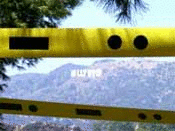An exhibition opening next week at San Francisco's Southern Exposure gallery asks some tough questions. Namely: "What does it mean to be an American now, and why would one want to identify as such, amid the current maelstrom of international bile directed at this country? What is the point in speaking out?" Not surprisingly, this less than optimistic premise gives the show its title, "Hopeless and Otherwise," but the thirteen artists included may manage to let some of the hot air out of the balloon of gloom bobbing above this sphere of angst. They do so by resisting emotional overreactions to social injustices, and instead offering proactive glances at the given scenarios. For instance, April Banks immersed herself in the West African cacao-processing cycle, in order to expose the contradictory lifestyle fantasies and foul labor policies perpetuated by the American chocolate industry. For Mary Walling Blackburn's, This Dream, This Frequency, the artist conversed with American soldiers in Iraq, via MySpace, and wove together audio recordings of their dreams with details of the dreams of Iraq's much more ancient inhabitants, as etched into ancient Mesopotamian tablets. Broadcast throughout San Francisco, over the air waves, the piece traces the historical fantasy-life of this ancient region. Both Alison Pebworth and The Renaming Bush Street Project explore our relationship to the spaces in which we live. Pebworth creates images drawing on historical figures and events, recorded mythologies, and speculative narratives about the future of the present. In this case, her work looks at the colonization of North America and the systematic sabotaging of its natural resources. The Renaming Bush Street Project turns on a similar question of viewers' relationship to the history of their own backyard, manifesting in a survey of local inhabitants regarding the possibility of renaming a major thoroughfare. Space continues to be a site for political inquiry in the work of photographer Michael Light, whose Two Burials And A Utility Corridor Looking Northwest; Forest Lawn Hollywood Hills Cemetery, Los Angeles, CA provides an aerial perspective on the intense influence of death upon the contemporary landscape, evoking a tension between the capitalist drive to develop and the human endeavor to rest in peace. Jonathan Santos's Gettysburg Address translates Abraham Lincoln's eponymous speech into Morse code, with the last line reading, "We here highly resolved that these dead shall not have died in vain--that this nation, under God, shall have a new birth of freedom--and that government of the people, by the people, for the people, shall not perish from the earth." The installation draws an all too often overlooked parallel between war and crime, while pointing out the unfortunate perpetuity of this nation's battle drive. Mark Tribe's Port Huron Project re-presents speeches from the New Left movements of the 60s and 70s, at their original sites. For this exhibition, he shows video of a reenactment of Howard Zinn's 1971 speech on Boston Common, in which the assembled audience reacts to the temporal reverb of Zinn's statement that "we need to do something to disturb that calm, smiling, murderous president in the White House." These and other projects by Siemon Allen, BLW, Melissa Day, The Journal of Aesthetics and Protest, Nathan Lynch, and The Visible Collective seem to indicate that there is a hope for change to be found in the repetition of history. - Marisa Olson
Jonathan Santos, Gettysburg Address, 2006 - 2008